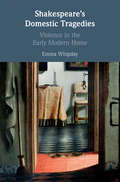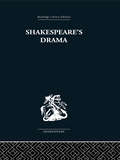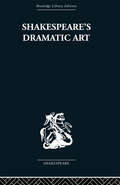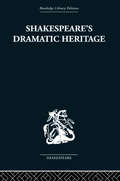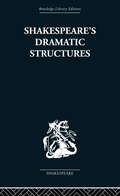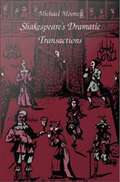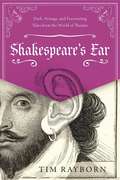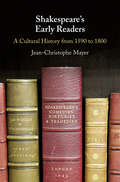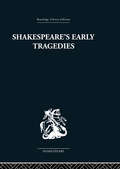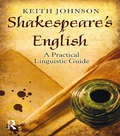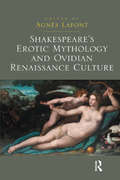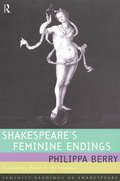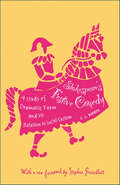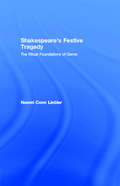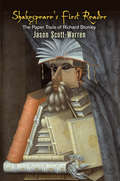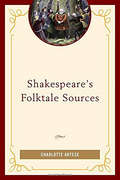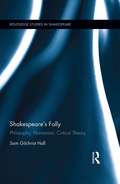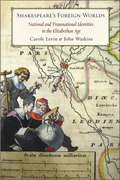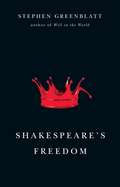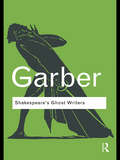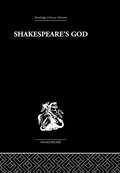- Table View
- List View
Shakespeare's Domestic Tragedies: Violence in the Early Modern Home
by Emma WhipdayDomestic tragedy was an innovative genre, suggesting that the lives and sufferings of ordinary people were worthy of the dramatic scope of tragedy. In this compelling study, Whipday revises the narrative of Shakespeare's plays to show how this genre, together with neglected pamphlets, ballads, and other forms of 'cheap print' about domestic violence, informed some of Shakespeare's greatest works. Providing a significant reappraisal of Hamlet, Othello, and Macbeth, the book argues that domesticity is central to these plays: they stage how societal and familial pressures shape individual agency; how the integrity of the house is associated with the body of the housewife; and how household transgressions render the home permeable. Whipday demonstrates that Shakespeare not only appropriated constructions of the domestic from domestic tragedies, but that he transformed the genre, using heightened language, foreign settings, and elite spheres to stage familiar domestic worlds.
Shakespeare's Drama
by Una Ellis-FermorFirst published in 1980. This collection of essays by the first General Editor of the New Arden Shakespeare brings together the best of Ellis-Fermor's Shespearean criticism, in addition to outstanding essays on Coriolanus and Troilus and Cressida. Collected and edited by Kenneth Muir, the book is prefaced by an appreciation of Ellis-Fermor's work.
Shakespeare's Dramatic Art: Collected Essays
by Wolfgang ClemenFirst published in 1972. Studying Shakespeare's 'art of preparation', this book illustrates the relationship between the techniques of preparation and the structure and theme of the plays. Other essays cover Shakespeare's use of the messenger's report, his handling of the theme of appearance and reality and the basic characteristics of Shakespearian drama.
Shakespeare's Dramatic Heritage: Collected Studies in Mediaeval, Tudor and Shakespearean Drama
by Glynne WickhamShakespeare's Dramatic Heritage shows that the drama of Elizabethan and Jacobean England is deeply indebted to the religious drama of the Middle Ages and represents a climax, in secular guise, to mediaeval experiment and achievement rather than a new beginning. This is fully examined in terms of dramatic literature as well as in terms of theatres, stages and production conventions. The plays studied include: Richard II, A Midsummer Night's Dream, Hamlet, Macbeth, Coriolanus, The Winter's Tale and Marlowe's King Edward II.
Shakespeare's Dramatic Structures
by Anthony BrennanFirst published in 1986. The focus of this book is the dramatic strategies of scenic repetition and character separation. The author traces the way in which Shakesperare often presents recurring gestures, dramatic interactions, and complex scenic structures at widely separated intervals in a play - thereby providing an internal system of cross-reference for an audience. He also examines the way in which Shakespeare increases the dramatic voltage in central relationships by limiting the access key characters have to each other on stage. These strategies, it is argued, are indelible marks of Shakespeare's craftsmanship which survive all attempts to obliterate it in many modern productions.
Shakespeare's Dramatic Transactions
by Michael E. MooneyShakespeare's Dramatic Transactions uses conventions of performance criticism--staging and theatrical presentation--to analyze seven major Shakespearean tragedies: Hamlet, Othello, King Lear, Macbeth, Antony and Cleopatra, Richard II, and Richard III. As scholars and readers increasingly question the theoretical models used to describe the concepts of "mimesis" and "representation," this book describes how the actor's stage presentation affects the actor's representational role and the ways in which viewers experience Shakespearean tragedy. Michael Mooney draws on the work of East German critic Robert Weimann and his concept of figurenposition--the correlation between an actor's stage location and the speech, action, and stylization associated with that position--to understand the actor/stage location relationship in Shakespeare's plays. In his examination of the original staging of Shakespeare's tragedies, Mooney looks at the traditional interplay between a downstage "place" and upstage "location" to describe the difference between non-illusionistic action (often staged near the audience) and the illusionistic, localized action that characterizes mimetic art. The innovative and insightful approach of Shakespeare's Dramatic Transactions brings together the techniques of performance criticism and the traditional literary study of Shakespearean tragedy. In showing how the distinctions of stage location illuminate the interaction among language, representation, Mooney's compelling argument enhances our understanding of Shakespeare and the theater.
Shakespeare's Ear: Dark, Strange, and Fascinating Tales from the World of Theater
by Tim RaybornShakespeare’s Ear presents dark and sometimes funny pieces of fact and folklore that bedevil the mostly unknown history of theater. All manner of skullduggery, from revenge to murder, from affairs to persecution, proves that the drama off-stage was just as intense as any portrayed on it. The stories include those of: An ancient Greek writer of tragedies who dies when an eagle drops a tortoise on his head. A sixteenth-century English playwright who lives a double life as a spy and perishes horribly, stabbed above the eye. A small Parisian theater where grisly horrors unfold on stage. The gold earring that Shakespeare wears in the Chandos portrait, and its connections to bohemians and pirates of the time. Journey back to see theatrical shenanigans from the ancient Near East, explore the violent plays of ancient Greece and Rome, revel in the Elizabethan and Jacobean golden age of blood-thirsty drama, delight in the zany and subversive antics of the Commedia dell’arte, and tremble at ghostly incursions into playhouses. Here you will find many fine examples of playwrights, actors, and audiences alike being horrible to each other over the centuries.
Shakespeare's Early Readers: A Cultural History from 1590 to 1800
by Jean-Christophe MayerWho were Shakespeare's first readers and what did they think of his works? Offering the first dedicated account of the ways in which Shakespeare's texts were read in the centuries during which they were originally produced, Jean-Christophe Mayer reconsiders the role of readers in the history of Shakespeare's rise to fame and in the history of canon formation. Addressing an essential formative 'moment' when Shakespeare became a literary dramatist, this book explores six crucial fields: literacy; reading and life-writing; editing Shakespeare's text; marking Shakespeare for the theatre; commonplacing; and passing judgement. Through close examination of rare material, some of which has never been published before, and covering both the marks left by readers in their books and early manuscript extracts of Shakespeare, Mayer demonstrates how the worlds of print and performance overlapped at a time when Shakespeare offered a communal text, the ownership of which was essentially undecided.
Shakespeare's Early Tragedies
by Nicholas BrookeFirst published in 1968. Shakespeare's Early Tragedies contains studies of six plays: Titus Andronicus, Richard III, Romeo and Juliet, Richard II, Julius Caesar and Hamlet. The emphasis is on the variety of the plays, and the themes, a variety which has been too often obscured by the belief in a single 'tragic experience'. The kind of experience the plays create and their quality as dramatic works for the stage are also examined. These essays develop an understanding of Shakespeare's use of the stage picture in relation to the emblematic imagery of Elizabethan poetry.
Shakespeare's English: A Practical Linguistic Guide
by Keith JohnsonShakespeare's English: A Practical Linguistic Guide provides students with a solid grounding for understanding the language of Shakespeare and its place within the development of English. With a prime focus on Shakespeare and his works, Keith Johnson covers all aspects of his language (vocabulary, grammar, sounds, rhetorical structure etc.), and gives illuminating background information on the linguistic context of the Elizabethan Age. As well as providing a unique introduction to the subject, Johnson encourages a "hands-on" approach, guiding students, through the use of activities, towards an understanding of how Shakespeare's English works. This book offers: · A unique approach to the study of Early Modern English which enables students to engage independently with the topic · Clear and engagingly written explanations of linguistic concepts · Plentiful examples and activities, including suggestions for further work · A glossary, further reading suggestions and guidance to relevant websites Shakespeare's English is perfect for undergraduate students following courses that combine English language, linguistics and literature, or anyone with an interest in knowing more about the language with which Shakespeare worked his literary magic.
Shakespeare's Englishes: Against Englishness
by Margaret Tudeau-ClaytonWhose English is 'true' English? What is its relation to the national character? These were urgent questions in Shakespeare's England just as questions of language and identity are today. Through close readings of early comedies and history plays, this study demonstrates how Shakespeare resists the shaping of ideas of the English language and national character by Protestant Reformation ideology. Tudeau-Clayton argues this ideology promoted the notional temperate and honest citizen, plainly spoken and plainly dressed, as the normative centre of (the) 'true' English. Compelling studies of two symmetrical pairs of cultural memes: 'the King's English' versus 'the gallimaufry' and 'the true-born Englishman' versus the 'Fantastical Gull', that demonstrate how 'the traitor' came to be defined as much by non-conformity to cultural 'habits' as by allegiance to the monarch. Tudeau-Clayton cogently argues Shakespeare subverted this narrow, class-inflected concept of English identity, proposing instead an inclusive, mixed and unlimited community of 'our English'.
Shakespeare's Erotic Mythology and Ovidian Renaissance Culture
by Agnès LafontTaking cross-disciplinary and comparative approaches to the volume’s subject, this exciting collection of essays offers a reassessment of Shakespeare’s erotic and Ovidian mythology within classical and continental aesthetic contexts. Through extensive examination of mythological visual and textual material, scholars explore the transmission and reinvention of Ovidian eroticism in Shakespeare’s plays to show how early modern artists and audiences collectively engaged in redefining ways of thinking pleasure. Within the collection’s broad-ranging investigation of erotic mythology in Renaissance culture, each chapter analyses specific instances of textual and pictorial transmission, reception, and adaptation. Through various critical strategies, contributors trace Shakespeare’s use of erotic material to map out the politics and aesthetics of pleasure, unravelling the ways in which mythology informs artistic creation. Received acceptions of neo-platonic love and the Petrarchan tensions of unattainable love are revisited, with a focus on parodic and darker strains of erotic desire, such as Priapic and Dionysian energies, lustful fantasy and violent eros. The dynamics of interacting tales is explored through their structural ability to adapt to the stage. Myth in Renaissance culture ultimately emerges not merely as near-inexhaustible source material for the Elizabethan and Jacobean arts, but as a creative process in and of itself.
Shakespeare's Feminine Endings: Disfiguring Death in the Tragedies (Feminist Readings of Shakespeare)
by Philippa BerryPhilippa Berry draws on feminist theory, postmodern thought and queer theory, to challenge existing critical notions of what is fundamental to Shakespearean tragedy. She shows how, through a network of images clustered around feminine or feminized characters, these plays 'disfigure' conventional ideas of death as a bodily end, as their figures of women are interwoven with provocative meditations upon matter, time, the soul, and the body. The scope of these tragic speculations was radical in Shakespeare's day; yet they also have a surprising relevance to contemporary debates about time and matter in science and philosophy.
Shakespeare's Festive Comedy: A Study of Dramatic Form and Its Relation to Social Custom
by C. L. BarberIn this classic work, acclaimed Shakespeare critic C. L. Barber argues that Elizabethan seasonal festivals such as May Day and Twelfth Night are the key to understanding Shakespeare's comedies. Brilliantly interweaving anthropology, social history, and literary criticism, Barber traces the inward journey--psychological, bodily, spiritual--of the comedies: from confusion, raucous laughter, aching desire, and aggression, to harmony. Revealing the interplay between social custom and dramatic form, the book shows how the Elizabethan antithesis between everyday and holiday comes to life in the comedies' combination of seriousness and levity. "I have been led into an exploration of the way the social form of Elizabethan holidays contributed to the dramatic form of festive comedy. To relate this drama to holiday has proved to be the most effective way to describe its character. And this historical interplay between social and artistic form has an interest of its own: we can see here, with more clarity of outline and detail than is usually possible, how art develops underlying configurations in the social life of a culture."--C. L. Barber, in the Introduction This new edition includes a foreword by Stephen Greenblatt, who discusses Barber's influence on later scholars and the recent critical disagreements that Barber has inspired, showing that Shakespeare's Festive Comedy is as vital today as when it was originally published.
Shakespeare's Festive Tragedy: The Ritual Foundations of Genre
by Naomi Conn LieblerShakespeare's Festive Tragedy is a unique look at the social and religious foundations of the tragic genre. Naomi Liebler asks whether it is possible to regard tragic heroes such as Coriolanus and King Lear as `sacrifical victims of the prevailing social order'. A fascinating examination of Shakespearean tragedy, this extraordinary book will provoke excitment and controversy alike.
Shakespeare's First Reader: The Paper Trails of Richard Stonley (Material Texts)
by Jason Scott-WarrenRichard Stonley has all but vanished from history, but to his contemporaries he would have been an enviable figure. A clerk of the Exchequer for more than four decades under Mary Tudor and Elizabeth I, he rose from obscure origins to a life of opulence; his job, a secure bureaucratic post with a guaranteed income, was the kind of which many men dreamed. Vast sums of money passed through his hands, some of which he used to engage in moneylending and land speculation. He also bought books, lots of them, amassing one of the largest libraries in early modern London.In 1597, all of this was brought to a halt when Stonley, aged around seventy-seven, was incarcerated in the Fleet Prison, convicted of embezzling the spectacular sum of £13,000 from the Exchequer. His property was sold off, and an inventory was made of his house on Aldersgate Street. This provides our most detailed guide to his lost library. By chance, we also have three handwritten volumes of accounts, in which he earlier itemized his spending on food, clothing, travel, and books. It is here that we learn that on June 12, 1593, he bought "the Venus & Adhonay per Shakspere"—the earliest known record of a purchase of Shakespeare's first publication.In Shakespeare's First Reader, Jason Scott-Warren sets Stonley's journals and inventories of goods alongside a wealth of archival evidence to put his life and library back together again. He shows how Stonley's books were integral to the material worlds he inhabited and the social networks he formed with communities of merchants, printers, recusants, and spies. Through a combination of book history and biography, Shakespeare's First Reader provides a compelling "bio-bibliography"—the story of how one early modern gentleman lived in and through his library.
Shakespeare's Folktale Sources
by Charlotte ArteseShakespeare’s Folktale Sources argues that seven plays—The Taming of the Shrew, Titus Andronicus, The Merry Wives of Windsor, The Merchant of Venice, All’s Well that Ends Well, Measure for Measure, and Cymbeline—derive one or more of their plots directly from folktales. In most cases, scholars have accepted one literary version of the folktale as a source. Recognizing that the same story has circulated orally and occurs in other medieval and early modern written versions allows for new readings of the plays. By acknowledging that a play’s source story circulated in multiple forms, we can see how the playwright was engaging his audience on common ground, retelling a story that may have been familiar to many of them, even the illiterate. We can also view the folktale play as a Shakespearean genre, defined by source as the chronicle histories are, that spans and traces the course of Shakespeare’s career. The fact that Shakespeare reworked folktales so frequently also changes the way we see the history of the literary folk- or fairy-tale, which is usually thought to bypass England and move from Italian novella collections to eighteenth-century French salons. Each chapter concludes with a bibliography listing versions of each folktale source as a resource for further research and teaching. Published by University of Delaware Press. Distributed worldwide by Rutgers University Press.
Shakespeare's Folktale Sources
by Charlotte ArteseShakespeare’s Folktale Sources argues that seven plays—The Taming of the Shrew, Titus Andronicus, The Merry Wives of Windsor, The Merchant of Venice, All’s Well that Ends Well, Measure for Measure, and Cymbeline—derive one or more of their plots directly from folktales. In most cases, scholars have accepted one literary version of the folktale as a source. Recognizing that the same story has circulated orally and occurs in other medieval and early modern written versions allows for new readings of the plays. By acknowledging that a play’s source story circulated in multiple forms, we can see how the playwright was engaging his audience on common ground, retelling a story that may have been familiar to many of them, even the illiterate. We can also view the folktale play as a Shakespearean genre, defined by source as the chronicle histories are, that spans and traces the course of Shakespeare’s career. The fact that Shakespeare reworked folktales so frequently also changes the way we see the history of the literary folk- or fairy-tale, which is usually thought to bypass England and move from Italian novella collections to eighteenth-century French salons. Each chapter concludes with a bibliography listing versions of each folktale source as a resource for further research and teaching. Published by University of Delaware Press. Distributed worldwide by Rutgers University Press.
Shakespeare's Folly: Philosophy, Humanism, Critical Theory (Routledge Studies in Shakespeare)
by Sam HallThis study contends that folly is of fundamental importance to the implicit philosophical vision of Shakespeare’s drama. The discourse of folly’s wordplay, jubilant ironies, and vertiginous paradoxes furnish Shakespeare with a way of understanding that lays bare the hypocrisies and absurdities of the serious world. Like Erasmus, More, and Montaigne before him, Shakespeare employs folly as a mode of understanding that does not arrogantly insist upon the veracity of its own claims – a fool’s truth, after all, is spoken by a fool. Yet, as this study demonstrates, Shakespearean folly is not the sole preserve of professional jesters and garrulous clowns, for it is also apparent on a thematic, conceptual, and formal level in virtually all of his plays. Examining canonical histories, comedies, and tragedies, this study is the first to either contextualize Shakespearean folly within European humanist thought, or to argue that Shakespeare’s philosophy of folly is part of a subterranean strand of Western philosophy, which itself reflects upon the folly of the wise. This strand runs from the philosopher-fool Socrates through to Montaigne and on to Nietzsche, but finds its most sustained expression in the Critical Theory of the mid to late twentieth-century, when the self-destructive potential latent in rationality became an historical reality. This book makes a substantial contribution to the fields of Shakespeare, Renaissance humanism, Critical Theory, and Literature and Philosophy. It illustrates, moreover, how rediscovering the philosophical potential of folly may enable us to resist the growing dominance of instrumental thought in the cultural sphere.
Shakespeare's Foreign Worlds: National and Transnational Identities in the Elizabethan Age
by Carole Levin John WatkinsIn Shakespeare's Foreign Worlds, Carole Levin and John Watkins focus on the relationship between the London-based professional theater preeminently associated with William Shakespeare and an unprecedented European experience of geographic, social, and intellectual mobility. Shakespeare's plays bear the marks of exile and exploration, rural depopulation, urban expansion, and shifting mercantile and diplomatic configurations. He fills his plays with characters testing the limits of personal identity: foreigners, usurpers, outcasts, outlaws, scolds, shrews, witches, mercenaries, and cross-dressers. Through parallel discussions of Henry VI, The Taming of the Shrew, and The Merchant of Venice, Levin and Watkins argue that Shakespeare's centrality to English national consciousness is inseparable from his creation of the foreign as a category asserting dangerous affinities between England's internal minorities and its competitors within an increasingly fraught European mercantile system. As a women's historian, Levin is particularly interested in Shakespeare's responses to marginalized sectors of English society. As a scholar of English, Italian Studies, and Medieval Studies, Watkins situates Shakespeare in the context of broadly European historical movements. Together Levin and Watkins narrate the emergence of the foreign as portable category that might be applied both to "strangers" from other countries and to native-born English men and women, such as religious dissidents, who resisted conformity to an increasingly narrow sense of English identity. Shakespeare's Foreign Worlds will appeal to historians, literary scholars, theater specialists, and anyone interested in Shakespeare and the Elizabethan Age.
Shakespeare's Freedom
by Stephen GreenblattShakespeare lived in a world of absolutes—of claims for the absolute authority of scripture, monarch, and God, and the authority of fathers over wives and children, the old over the young, and the gentle over the baseborn. With the elegance and verve for which he is well known, Stephen Greenblatt, author of the best-selling Will in the World, shows that Shakespeare was strikingly averse to such absolutes and constantly probed the possibility of freedom from them. Again and again, Shakespeare confounds the designs and pretensions of kings, generals, and churchmen. His aversion to absolutes even leads him to probe the exalted and seemingly limitless passions of his lovers. Greenblatt explores this rich theme by addressing four of Shakespeare’s preoccupations across all the genres in which he worked. He first considers the idea of beauty in Shakespeare’s works, specifically his challenge to the cult of featureless perfection and his interest in distinguishing marks. He then turns to Shakespeare’s interest in murderous hatred, most famously embodied in Shylock but seen also in the character Bernardine in Measure for Measure. Next Greenblatt considers the idea of Shakespearean authority—that is, Shakespeare’s deep sense of the ethical ambiguity of power, including his own. Ultimately, Greenblatt takes up Shakespearean autonomy, in particular the freedom of artists, guided by distinctive forms of perception, to live by their own laws and to claim that their creations are singularly unconstrained. A book that could only have been written by Stephen Greenblatt, Shakespeare’s Freedom is a wholly original and eloquent meditation by the most acclaimed and influential Shakespearean of our time.
Shakespeare's Freedom (Campbell Lectures)
by Stephen GreenblattShakespeare lived in a world of absolutes—of claims for the absolute authority of scripture, monarch, and God, and the authority of fathers over wives and children, the old over the young, and the gentle over the baseborn. With the elegance and verve for which he is well known, Stephen Greenblatt, author of the best-selling Will in the World, shows that Shakespeare was strikingly averse to such absolutes and constantly probed the possibility of freedom from them. Again and again, Shakespeare confounds the designs and pretensions of kings, generals, and churchmen. His aversion to absolutes even leads him to probe the exalted and seemingly limitless passions of his lovers. Greenblatt explores this rich theme by addressing four of Shakespeare’s preoccupations across all the genres in which he worked. He first considers the idea of beauty in Shakespeare’s works, specifically his challenge to the cult of featureless perfection and his interest in distinguishing marks. He then turns to Shakespeare’s interest in murderous hatred, most famously embodied in Shylock but seen also in the character Bernardine in Measure for Measure. Next Greenblatt considers the idea of Shakespearean authority—that is, Shakespeare’s deep sense of the ethical ambiguity of power, including his own. Ultimately, Greenblatt takes up Shakespearean autonomy, in particular the freedom of artists, guided by distinctive forms of perception, to live by their own laws and to claim that their creations are singularly unconstrained. A book that could only have been written by Stephen Greenblatt, Shakespeare’s Freedom is a wholly original and eloquent meditation by the most acclaimed and influential Shakespearean of our time.
Shakespeare's Ghost Writers: Literature As Uncanny Causality (Routledge Classics Ser.)
by Marjorie GarberThe plays of Shakespeare are filled with ghosts - and ghost writing. Shakespeare's Ghost Writers is an examination of the authorship controversy surrounding Shakespeare: the claim made repeatedly that the plays were ghost written. Ghosts take the form of absences, erasures, even forgeries and signatures - metaphors extended to include Shakespeare himself and his haunting of us, and in particular theorists such Derrida, Marx, Nietzsche, and Freud - the figure of Shakespeare constantly made and remade by contemporary culture. Marjorie Garber, one of the most eminent Shakespearean theorists writing today, asks what is at stake in the imputation that "Shakespeare" did not write the plays, and shows that the plays themselves both thematize and theorize that controversy. This Routledge Classics edition contains a new preface and new chapter by the author.
Shakespeare's Ghost Writers: Literature as Uncanny Causality
by Marjorie GarberThe plays of Shakespeare are filled with ghosts – and ghost writing. Shakespeare's Ghost Writers is an examination of the authorship controversy surrounding Shakespeare: the claim made repeatedly that the plays were ghost written. Ghosts take the form of absences, erasures, even forgeries and signatures – metaphors extended to include Shakespeare himself and his haunting of us, and in particular theorists such Derrida, Marx, Nietzsche, and Freud – the figure of Shakespeare constantly made and remade by contemporary culture. Marjorie Garber, one of the most eminent Shakespearean theorists writing today, asks what is at stake in the imputation that "Shakespeare" did not write the plays, and shows that the plays themselves both thematize and theorize that controversy. This Routledge Classics edition contains a new preface and new chapter by the author.
Shakespeare's God: The Role of Religion in the Tragedies
by Ivor MorrisFirst published in 1972. Shakespeare's God investigates whether a religious interpretation of Shakespeare's tragedies is possible. The study places Christianity's commentary on the human condition side by side with what tragedy reveals about it. This pattern is identified using the writings of Christian thinkers from Augustine to the present day. The pattern in the chief phenomena of literary tragedy is also traced
